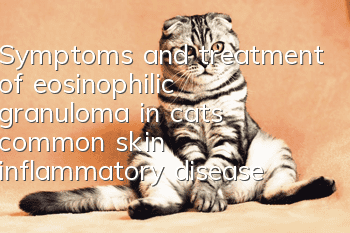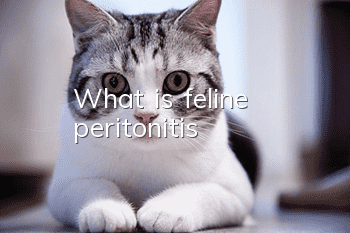Symptoms and treatment of eosinophilic granuloma in cats, common skin inflammatory diseases

What is feline eosinophilic granuloma
Feline eosinophilic granuloma is a common skin inflammatory disease in cats. The disease is usually found on the skin, oral cavity, etc. Many people confuse this disease with lymphocytic gingivitis, so we are here to treat it. Let me introduce the disease.
Feline eosinophilic granuloma complex (EGC) is not a idiopathic disease, but rather a pattern of multiple skin reactions in cats. At present, there are three classic classifications of feline eosinophilic granuloma: 1. Painless ulcer 2. Eosinophilic plaque 3. Eosinophilic granuloma. These lesions may appear at the same time, because they may appear in the same patient and may also affect each other. Same treatment response.
Eosinophilic granuloma is not breed-specific, but female cats appear to be more susceptible. Affected cats usually affect young to middle-aged cats (mean age 3.5 years) and are generally associated with peripheral lymphadenopathy. Prolonged and more severe eosinophilic granulomas are often associated with chronic immune stimulation and can induce cell-line gammopathy.
The cause of EGC is unknown; however, underlying hypersensitivities such as food allergies, atopic allergies, or insect allergies (especially flea and mosquito allergies) are often associated with these lesions. Since antibiotic treatment completely or significantly improves some lesions, this also implies that bacterial infection may be present. However, the effects of antibiotic treatment may be due to immunomodulatory effects rather than antimicrobial effects. EGC may have a genetic predisposition, as eosinophilic granulomas and painless ulcers have been cloned in SPF cats and other cats with restricted genetic diversity. Some people also believe that ECG is an autoimmune disease, because anti-epithelial autoantibodies have been found in sick cats. Some epithelial injuries and skin reactions in cats with ECG release altered antigens, leading to the release of autoantibodies.
What are the symptoms of feline eosinophilic granuloma
Feline eosinophilic granuloma occurs in many locations, but most of them occur in the oral cavity. It is an ulcerative lesion, and ulcers can occur on one side or both sides. This is a chronic ulcer that occurs on the lips, causing the mucosa in the mouth and the ulcer site of the lips to become sticky, resulting in the formation of granulations.
Eosinophilic granuloma occurs on the back of the thighs, face, and mouth (especially the tongue and palate). Lesions also occur on the feet. Skin lesions have the following typical symptoms: localized onset, well-defined, raised, hard, hairless, erythema, with a typical linear structure. These lesions are usually painless and non-itchy.
Lesions on the face and in the mouth have a papular to nodular appearance and are one of the common causes of lower lip edema (outward protrusion) in cats, as well as asymptomatic chin edema (fat-chin Cats, cat jaw edema). If erosion or ulcer appears on the surface, obvious plaques with white lesions can be seen. Cats suffering from oral lesionsDifficulty swallowing may occur.
How to treat eosinophilic granuloma in cats
The real cause of eosinophilic granuloma is not yet clear, but it is certain that bacterial infection is one of the causes of the disease. Therefore, antibiotics have a more obvious effect on the disease, but antibiotic treatment may have an effect. It is because of the immunomodulatory effect rather than the antibacterial effect.
Immunosuppressive therapy is the most commonly used treatment regimen and systemic corticosteroids are usually effective. Cats have very few steroid receptors on their cells, so cats require larger amounts of steroids than other breeds. Prednisone or prednisolone can be taken by mouth until the lesion heals. Or inject methylprednisolone acetate. Or oral glucocorticoids (may also be effective. Recurrence of lesions requires oral glucocorticoids every other day or repeated subcutaneous injections of methylprednisone (this drug should not be repeated within 2 months). Significant improvement requires 2- 4 weeks. As lesions improve, glucocorticoids should be tapered to the lowest maintenance dose. Omega-3/omega-6 fatty acids are effective in some cats, which may help reduce glucocorticoid dosage.
For those cases in which glucocorticoids do not respond, immunomodulation can be used as a back-up option. Some cats respond to systemic antibiotics in 2-3 weeks. Other immunomodulators include chlorambucil, levamisole, thiabendazole, and alpha interferon. But some studies suggest that alpha interferon has no role in eosinophilic plaques and granulomas. Other types of treatment that occasionally help include radiation therapy, cryosurgery and laser therapy, surgical excision, and mixed bacterial vaccines. There are also unpublished reports of occlusive biosynthetic absorbable wound bandages showing results after 48 hours of application to the wound. After taking the medicine, the itching of the lesion was significantly reduced. Pregnancy-stimulating drugs, such as megestrol acetate, have also been used successfully; however, these drugs have too many side effects and are not recommended.
- Why do cats like to stay in pens?
- Why can pet cats climb high?
- The cat keeps panting and has shortness of breath.
- What do cats need to prepare for giving birth?
- What causes cats to fart?
- How to train Bengal cats? What are your opinions?
- Why does a cat's hind legs feel weak and cramped?
- How to buy a pure Persian cat? How to buy a pure Persian cat!
- Why can’t cats eat protein?
- Why doesn't the cat poop?



